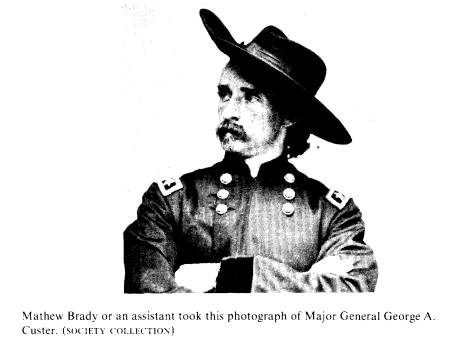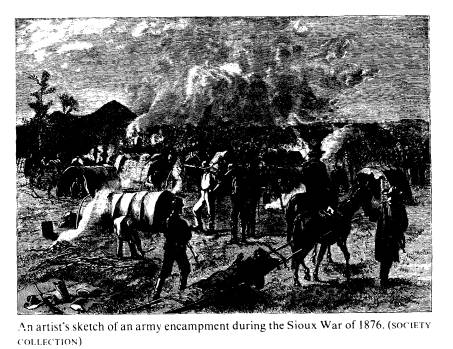Ohio History Journal
BRUCE A. ROSENBERG
Another Look at
George Armstrong Custer
Custer in the Civil War: His Unfinished Memoirs. Compiled and edited by
John M. Carroll. (San Rafael, CA:
Presidio Press, 1977. 233p.;
illustrations, bibliographic checklist,
index. $27.50.)
Centennial Campaign: The Sioux War of
1876. By John S. Gray. (Fort
Collins, CO: The Old Army Press, 1976.
392p.; bibliography, maps,
index. $20.00.)
Li/e in Custer's Ca\valr:
Diaries and Letters of Albert and Jennie Barnitz,
1867-1868. Edited by Robert M. Utley. (New Haven: Yale University
Press, 1977. xiv +- 302p.;
illustrations, appendices, bibliography,
index. $15.00.)
More than a century ago "Custer
achieved an immortality," writes
Robert Utley, "that a dozen
brilliant victories could not have earned him,"
one of those truisms that is
incontestable because obvious. This perplexing
man, whom author John Carroll calls
"a great officer and leader of men,"
whom fellow officer Albert Barnitz
called "The most complete example of a
petty tyrant that I have ever
seen," is also justly appraised by Utley as a
"repository of a host of baffling
contradictions," a "paradoxical combina-
tion of virtue and vice." The
battle in which he lost his life, gloriously or
ignobly is uncertain, was relatively
small in scope and of itself minor. But it
has become the most popularly known
conflict in American history, the
subject of more than one thousand
paintings and illustrations, of more
than a score of movies, and of hundreds
of essays and books. The three
reviewed here are merely among the most
recent; they will not be the last.
One of the most cogent evidences of the
enduring fascination of Custer's
character and achievement is the
devotion afforded him by such men as
John Carroll, author and editor of nearly
a dozen books on his hero.
Carroll is an ardent champion of
Custeriana and a fervent apologist;
among the devotees in the Custer
cult-the Associates of The Little Big
Bruce A. Rosenberg is Professor of
English at Brown University.
|
74 Onto hISTORY |
|
|
|
Horn he is one of the most reverent and assiduous. But in this volume partisanship is no issue: it is a collection of records, Custer's serialized memoirs, and a bibliography. Editor Carroll has added almost no com- ment of his own. though the thoroughness of his labors is always noticea- ble. Part I of this tome mainly a source-book presents the gleanings of the 130 volume W11ar of the Rebellion: A Compilatiotn of the Official Recordx of Tlhe (nion and Confederate Records. A second section reprints several of Custer's autobiographical essays carried by Galaxy Magazine during the spring of 1876. A few of these are interesting: all are literate. But nowhere, one feels, does the real George A. Custer emerge, even (or especially'?) when he describes his embarrassed gaffes during his first combat. A final section lists the more than 550 articles and books which at least mention Custer in the Civil War. Most of these bibliographical entries are sparsely annotated and of almost no value to a Custer biographer. A typical annotation informs us that the writing "contains a few Custer mentions" or "has some Custer mentions." Equally unhelpful are such comments from the records of Part I as "were in engagement at Gettysburg," or "was engaged at Monterey Pass." Like so much of Custeriana, this material holds no interest for the professional historian. But it is, all of it, of the utmost interest and concern to the Custerphile. And it is to this person. and there |
|
Another Look at Custer 75 |
|
|
|
are many of them in America today, that Carroll's book will have its strongest appeal. For the rest of us, the inaccessable Galaxy articles are the most attractive. Of broader interest is John Gray's Centennial Campaign, a chronicle of the 1876 war against the Sioux. Like most authors of books on Custer, Gray is an interested nonprofessional. And his pages often reveal his passionate commitments. Not that Gray is an unreconstructed Custerphile, but he does take sides in several of the issues he discusses, and the intrusion of his opinions into what should have been the dispassionate presentation of data is distracting and tends to make one wary of even his most convincing arguments. Nevertheless, what Gray lacks in professional distancing he almost makes up for in attention to detail and to contempor- ary sources (used almost exclusively): he gives a great deal of information about both prelude and aftermath of the "Last Stand" seldom included in histories of the battle, and his work is valuable for that reason alone. Gray makes a number of unsupported evaluations of events and personalities; yet he also examines some aspects of the battle in such detail--for instance, Benteen's "valley-hunting" assigment--as to be definitive. Robert Utley has written widely on the West, and he is among the two or |
76 OHIO IIISTORY
three ablest historians on the subject.
The diaries and letters of Albert and
Jenny Barnitz (he was an officer in the
Seventh Cavalry until seriously
wounded at the Washita) is not a major
work of history, bht one of great
interest. Maj. Barnit7 greatly admired
Custer during the Civil War, but
while on duty on the plains he changed
his mind about his commander
radically: . . . I should never associate with him on terms of
intimacy,"
he wrote to Jenny in May of 1867,
"because by his recent unfeeling
treatment of enlisted men of this
command and shameful discourtesy to
officers, he has proved himself unworthy
of the respect of all right-minded
men."
The light that the opinions of one of
Custer's articulate colleagues sheds
upon "The Boy General" is only
part of the interest of this book. Also
revealed is a warm and vivid picture of
life in the frontier army in many of
its perspectives; it is a canvas colored
by a sensitive and perceptive
observer. Ultley has carefully edited
his material, never intruding on the
reader, yet always providing just enough
information to keep us informed
about trivial people and minor events.
This is perhaps the most engaging
personal history of the army of the
frontier, of those "pioneers in blue."
When we wonder, then, at the great
expense of energy still being spent
upon Custer, we wonder, however
unconsciously, at the emotional allure
of the battle in which Custer was killed,
without which we would hardly
hear of its martyred hero at all. Is it
really worthwhile after all'? Is this man
who did little to change the course of
American history or alter its thought
worth all the ink, the paint, the
celluloid? For many obviously not. But for
many others the question answers itself.
Custer continues to live in the
minds and imaginations of many
thousands, to inspire some men to spend
decades of their lives to write books
about him and others to spend between
$15 and $27 to read about him.
We also wonder, however, how much more
conventional history needs
to be written about the Little Big Horn
and its defeated colonel? In how
much more detail do we need to study
this battle which, after all. tells us
very little about westward expansion.
the course of empire. or the behavior
of man. My own interest in the Custer
phenomenon concerned the heroic
"epic" that Americans,
collectively, made of the few known facts of the
disaster: not what happened, so much,
but rather what millions of white
Americans chose to believe had happened,
and the narrative that emerged
as an expression of those beliefs. And
subsequent to the appearance of
Cu.ster and The Ep�ic of I)efrat in 1974, Brian Dippie has published an
important book on the Custer
"Myth" which details the important Custer
productions in popular art.
In my own jaded opinion, this is the
approach that will tell us the most
about the man and his Stand: why do we
think he (and it) so important'?
Another Look at Custer 77
What does our understanding of his life
and the battle that ended it say
about us and our attitudes -- toward
Indians in particular and bravery in
general? How do such legends come about,
and are they then predictable'
Despite the scornful disclaimers of
academic historians, Custer is very
important but not for the reasons they
usually ascribe to "important"
people. Despite the disdain of
professional historians, Custer is interesting.
even fascinating. John Carroll, John
Gray, and Robert Utley are fascinated
and have written interesting books to
show it. For even as I write these
questions about whether Custer is worth
all this bother, I read all three of
these books with something nearing
unalloyed interest.

